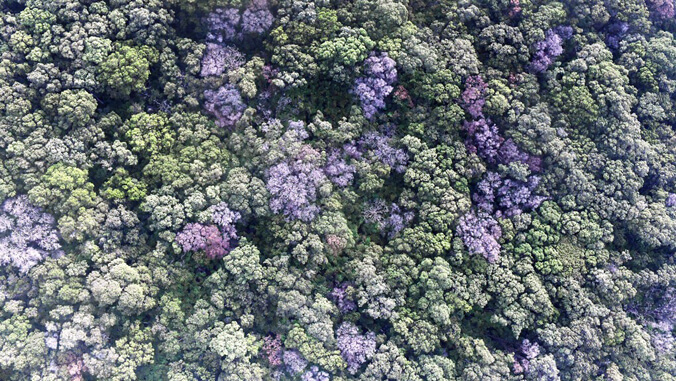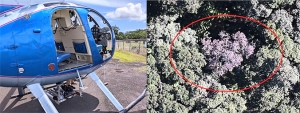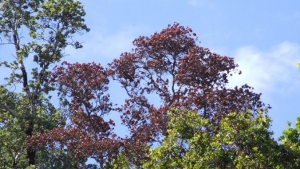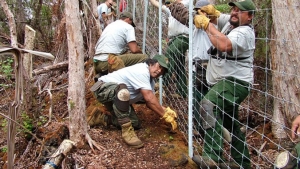
New findings reveal the spread of a fungal disease killing off hundreds of thousands of mature ʻōhiʻa trees (Metrosideros polymorpha) on Hawaiʻi Island could be exacerbated by the presence of ungulates or animals with hooves. A geographer at the University of Hawaiʻi at Hilo, along with colleagues from the National Park Service, U.S. Forest Service and U.S. Department of Agriculture, published a collaborative study that closely examines the link between the disease known as rapid ʻōhiʻa death (ROD) and ungulates such as feral pigs.

Lead investigator of the study, Ryan Perroy, an associate professor of geography and environmental science at UH Hilo, specializes in remote sensing and was integral in obtaining aerial imagery to detect ʻōhiʻa mortality at an individual tree level. The study’s co-authors collected field samples and conducted laboratory testing using data from impacted areas within Hawaiʻi Volcanoes National Park (HAVO) and the Laupāhoehoe Forest Reserve.
The spatial patterns of ʻōhiʻa mortality observed across all four sites included in the study show significant differences in areas with and without ungulates, suggesting that ungulate exclusion is an effective management tool to lessen the impacts of ROD in forested areas in Hawaiʻi.
“The results from this work show us that the impacts of ROD can vary across the landscape,” said Perroy. “We hope this information can be useful in managing and caring for our native forests.”
Perroy leads the UH Hilo Spatial Data Analysis & Visualization Research Laboratory alongside Timo Sullivan and Daniel Duda. They all joined forces with a Hawaiʻi Island-based research team, which includes David Benitez, an ecologist at HAVO; Flint Hughes, an ecologist at the Institute of Pacific Islands Forestry; and Lisa Keith, Eva Brill and Karma Kissinger, plant pathologists from the Daniel K. Inouye U.S. Pacific Basin Agricultural Research Center.
The researchers discovered the number of suspected ROD trees in unfenced areas were significantly higher (more than 50 times greater for one location) than those found in fenced areas that prevent hoofed animal access.
- Related UH News story: Tracking the spread of Rapid ʻŌhiʻa Death on Kauaʻi, October 12, 2020
ROD was first discovered on Hawaiʻi Island in 2014 and has since obliterated hundreds of acres of once sprawling ʻōhiʻa. It is also found on Kauaʻi, Maui and Oʻahu. The deadly disease is caused by two invasive fungi, Ceratocystis huliohia and Ceratocystis lukuohia, and, if left unstopped, could irreversibly change Hawaiian ecosystems and cultural traditions by diminishing the keystone native tree in Hawaiian forests.
Study enhances ROD data collection

Based on collected aerial imagery, the researchers developed a rating system based on tree canopy condition to identify ʻōhiʻa that may be infected. They developed a custom imaging system for helicopter mapping operations, which enables a much wider surveying scale.
Using this system, the researchers quickly generate and share suspect tree candidate locations with partner agencies to rapidly detect new mortality outbreaks and prioritize field sampling efforts. The studies revealed disparities between sites, illustrating challenges to definitively determine the cause of ʻōhiʻa mortality from aerial imagery alone. The integrated approach of imagery, field sampling and lab work proved better at effectively discerning causative factors.
This research identifies effective strategies for HAVO and other protected areas, where study co-author Benitez considers ROD to be a top threat to native forests and ecosystems. “The focal sites include forests near the summit of Kīlauea, including Nāhuku and the ʻŌlaʻa Tract rainforests and the Kahuku Unit,” Benitez explained. “We are very excited about this collaborative research, and the resulting technologies such as a safer and more cost effective airborne mapping system which can pinpoint ROD outbreaks across vast areas on all Hawaiian Islands.”
Need for feral animal control

An unexpected event at one of the study sites showed the impact feral pigs caused after they breached a fenced area. Suspect ROD tree densities in the area rose from practically none to nearly three trees per hectare (nearly 2.5 acres) highlighting the need for ungulate control.
“There are lots of remaining questions that still need to be addressed relating to ungulate species-specific behavior and impacts (pigs vs. goats vs sheep vs. cattle), differences between domesticated and feral animals, and lots of remaining questions regarding non-ungulate factors we think play a role in ʻōhiʻa mortality, from boring beetles to storm events,” said Perroy.
The paper also illustrates the importance of removing infected trees to suppress ʻōhiʻa mortality levels across affected regions.
For more go to UH Hilo Stories.
—Story by Susan Enright

